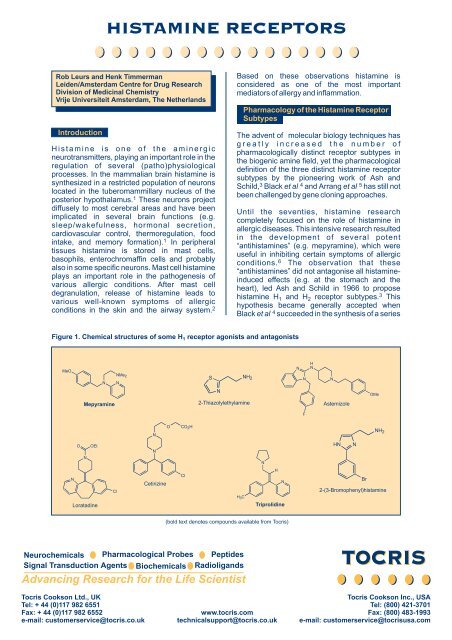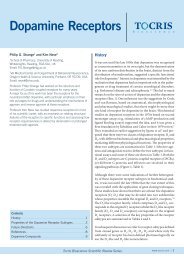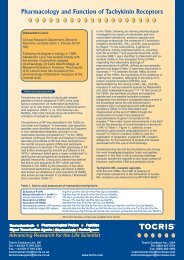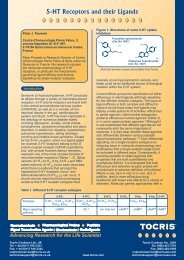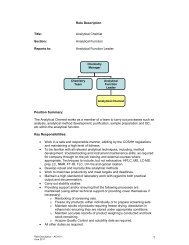HISTAMINE RECEPTORS
HISTAMINE RECEPTORS
HISTAMINE RECEPTORS
You also want an ePaper? Increase the reach of your titles
YUMPU automatically turns print PDFs into web optimized ePapers that Google loves.
of new compounds (e.g. burimamide, cimetidine),which were able to block the effects of histamineon the stomach and the heart. These H2receptorantagonists proved to be very useful in the therapyof gastric ulcers. In recent years it becameapparent that histamine also functions as aneurotransmitter. 1 As with many otherneurotransmitter systems, a presynaptic receptorfor histamine (H ) exists as well. 53This receptorsubtype regulates the release and synthesis ofhistamine (autoreceptor), but is also involved inthe regulation of the release of many otherimportant neurotransmitters, such asnoradrenaline, dopamine, serotonin andacetylcholine (heteroreceptor). 7Selective Ligands for the Three HistamineReceptor SubtypesFor all three receptor subtypes selective agonistsand antagonists are available.H1ReceptorsModification of the imidazole moiety of histaminehas been the most successful approach forobtaining selective H1agonists (figure 1). Thepresence of the tautomeric N-Nsystem of theimidazole ring is not obligatory, as reflected by theselective H1agonists 2-pyridylethylamine and 2-thiazolylethylamine. Substitution of the imidazolering at the 2-position leads to relatively selectiveH1agonists. For example, 2-( meta-halogenated)phenylhistamines are relatively potent H1receptoragonists at the guinea-pig ileum; 8 however, thesecompounds act as partial agonists in othersystems. 9 A wide array of potent and selective H1antagonists are available. 6 Compounds such asmepyramine (also called pyrilamine) andtriprolidine (figure 1) are highly potent H1antagonists and very useful tools forpharmacological investigations. [ 3H]-mepyramineis, for example, successfully used as an H1receptor radioligand.10These so-called classical“antihistamines” easily penetrate the brain andare therefore also useful in in vivo studies.Clinically, the CNS penetration of these drugscauses sedation. Elimination of the blood-brainbarrierpassage by some minor structuralmodifications (figure 1) has resulted in many new,non-sedating H1antagonists (e.g. cetirizine,astemizole or loratadine), that are currentlysuccessfully marketed to treat allergicconditions. 6H2ReceptorsThe first selective H2receptor agonist, dimaprit,was found during a search for H2receptorantagonists in a series of isothiourea derivatives.Dimaprit is a relatively selective H2receptoragonist; it is almost as active as histamine at theH2 receptor, but hardly displays any H1receptoragonism11and is a moderate H3receptorantagonist. 12 Recently, amthamine (2-amino-5-(2-aminoethyl)-4-methylthiazole), a rigid dimapritanalog (figure 2), has been developed. Thiscompound combines a high H2receptor selectivitywith a potency which is slightly higher comparedto histamine, both in vitro and in vivo. 13, 14 An H2receptor agonist that is also more potent thanhistamine is the guanidine derivative impromidine(figure 2). This ligand actually combines a ratherhigh H2receptor affinity with a reduced efficacy.Impromidine also shows moderate and potentantagonistic activity at the H1- and the H3receptorrespectively. 5, 15The finding that N-guanylhistamine acts as apartial H2agonist in a gastric acid secretion testled to the development of the relatively weak H2antagonist burimamide (figure 2), which was agood lead for the development of clinically usefulH receptor antagonists. 42Subsequently, manycompounds with H2receptor antagonisticproperties, such as cimetidine, have beenFigure 2. Chemical structures of some H receptor agonists and antagonists2Me 2 N S NHDimapritNH 2H 2 NCH 3NSNH 2AmthamineHNNNHNHNHImpromidineSMeHNNNNHHNHNSCH 3CH 3 NCNCimetidineHNNBurimamideHNSHNMeNH 2 NH 2 N N SOMe 2 NSSTiotidineHNNCHNNHNHNMeMeSNNHOZolantidineNH 2 NH 2 NNSNSFamotidineHN NH 2NSO 2 NH 2RanitidineO 2 N(bold text denotes compounds available from Tocris)2
developed.16, 17Most of these H2blockers can beconsidered as having small variations on ageneral structure. The 4-methylimidazole moietyof cimetidine can easily be replaced by otherheterocyclic groups (figure 2). Replacement by asubstituted furan- (e.g. ranitidine) or thiazole ring(e.g. tiotidine and famotidine) leads to compoundsthat are usually more potent at the H2receptorcompared to cimetidine. Moreover, thereplacement of the imidazole moiety alsoeliminates the undesired inhibition of cytochromeP-450. 17 The potent H2antagonists tiotidine andiodoaminopotentidine are successfully used astritiated and iodinated radioligands for the H2receptor respectively. 10 The newly developedbrain-penetrating H2antagonist zolantidine is animportant tool for in vivo CNS studies. 18Very recently, the H2receptor was reported to bespontaneously active in transfected CHO cells. 19Based on this concept, the H2antagonists werereclassified; cimetidine, ranitidine and famotidineare in fact inverse agonists, whereas burimamideacts in this model system as a neutralantagonist. 19H3ReceptorsAt the histamine H3receptor, histamine itself is ahighly active agonist. Mono- or dimethylation ofthe terminal amino function results in compoundsthat are more active and H3selective with regardto H1 and H2receptors, than histamine.Methylation of the -carbon atom of theethylamine sidechain drastically increases thepotency at the H3receptor. This increased activityresides completely in the R-isomer; thecorresponding S-isomer is approximately 100-fold less potent. Since the methylation leads tohighly reduced activity at both the H1- and H2receptor, R-( )-methylhistamine (figure 3) is avery selective agonist at the H3receptor. Incombination with its less active S-isomer, thiscompound has proven to be highly useful for thepharmacological characterisation of H3receptormediatedeffects.12Tritiated forms of N-methylhistamine and R-( )-methylhistamine arecurrently available as radiolabelled agonists forthe H receptor. 123For potent H3agonism, theamine function of histamine can be replaced by anisothiourea group, as in imetit (figure 3). Imetit isalso very active in vitro and in vivo, 20-22as is R-( )-methylhistamine. The amine function can also beincorporated in ring structures to producecompounds such as immepip (figure 3). Thiscompound again, is effective in vitro and in vivo.23Moreover, whereas R-( )-methylhistamine showssome H1 and 2agonistic activity and imetit actsas a 5-HT3agonist, 24-26 immepip is devoid ofthese activities. 25Various H2receptor selective agents are alsorather potent H receptor antagonists. 53Themoderately active H2antagonist burimamide (pA2= 5.1) is an effective H3antagonist (pA 2= 7.2), andsome H2agonists (impromidine and dimaprit) arealso active as H receptor antagonists. 53Thedistinct pharmacology of the H3receptor wasconfirmed by the development of the prototypic H3receptor antagonist thioperamide (figure 3). 27This compound is active in various in vitro H3receptor assays but shows some 5-HT3receptorantagonism. 26 Thioperamide penetrates the CNSand has been used in several in vivo studies.Based on the H3receptor agonist imetit, the highlypotent antagonists clobenpropit (figure 3) andiodophenpropit were developed. 22 Thesecompounds also show some 5-HT3receptorantagonism26and do not readily penetrate theCNS. 28 Recently, a variety of other potent H3receptor antagonists have been described,including impentamine, GT2016 andiodoproxyfan (figure 3). 29 Consequently, variousantagonists have been described as radioligandsfor the H3receptor (e.g. [ 125I]-iodophenpropit and[ 125I]-iodoproxyfan).30, 31Figure 3. Chemical structures of some H receptor agonists and antagonists3NNHMeNH 2NNHImetitSNH 2NHHNNOIodoproxyfanIR-( )-MethylhistamineHNNNHNSHNNImmepipNHNNHS NHClThioperamideNHClobenpropitOHNNNGT 2016HNNImpentamineNH 2(bold text denotes compounds available from Tocris)3
Molecular Biology of Histamine ReceptorsBoth the histamine H1 and H2receptor belong tothe large family of G-protein coupled receptors(GPCRs). The cDNA encoding a bovine H1receptor protein was cloned in 1991 after anexpression cloning strategy in Xenopusoocytes. 32 The deduced amino acid sequencerevealed a 491 amino acid protein of 56 kDa.Using the cDNA sequence encoding the bovineH1receptor, the cDNA sequences and intronlessgenes encoding the rat, 33 guinea-pig, 34, 35human36-39 and mouse40H1receptor proteinswere cloned soon thereafter. The proteins areslightly different in length, highly homologous anddo not show major differences in pharmacology.Analysis of the 5-flanking region of the human, ratand guinea-pig gene33, 34, 36 resulted in theidentification of several DNA-binding motifs,including potential glucocorticoid responsiveelements. The human H1receptor gene resideson chromosome 3. 41Gantz et al 42 were the first to clone a cDNAencoding a 359 amino acid H2receptor. Usingdegenerate primers based on the knownsequence similarity of various GPCRs, the H2receptor sequence was obtained from caninegastric parietal cDNA by PCR. Soon thereafter,the intronless genes encoding the rat, 43 human, 44guinea-pig45 and mouse46H2receptor werecloned by means of homology screening. As forthe H1receptor, the receptor proteins are slightlydifferent in length, but do not show majorpharmacological differences. Identification of thepromotor region of the human H2receptor generevealed the existence of regulatory transcriptionsites and regions displaying stimulatory andinhibitory effects on gene expression monitored ina luciferase assay. 47 Recent studies haveindicated that the human H2receptor gene resideson chromosome 5. 45 Interestingly, severalpolymorphisms have been found in the human H2receptor gene48and one of the mutations hasbeen linked to schizophrenia. 49Although the genetic information for the H1and H2receptor has been available for some years now,as yet no information on the primary structure ofthe H receptor is known.3Signal Transduction of the HistamineReceptorsThe histamine H1receptor is associated with thephospholipase C-catalyzed formation of inositol1,4,5-triphosphate (IP 3) and 1,2-diacylglycerol(DAG). Histamine induces production of inositolphosphates in several tissues (including brain,airway, intestinal and vascular smooth muscle 10)via a pertussis toxin-insensitive G-protein.Although the G-protein probably belongs to theG q/G11family, the actual nature of the pertussintoxin-insensitive G-protein remains unclear. SinceCa2+is involved in the regulation of many cellularfunctions, the increase of the intracellular Ca2+concentration following H1receptor stimulationcan explain a variety of cellular responses, suchas nitric oxide production, cAMP and cGMPaccumulation and phospholipase A2andphospholipase D activation. 10 Yet, studies with G-protein toxins and in calcium-free mediumindicate that both the H1receptor-mediatedactivation of phospholipase A2and cAMPelevation are also mediated by an unknown,secondary mechanism (G-protein mediated?).The histamine H2receptor is coupled to theadenylate cyclase system in a variety of tissues(e.g. brain, stomach, heart, gastric mucosa,lung). 10 Moreover, cell lines transfected with thecloned H2receptor genes showed an H2receptor-mediated increase of cAMP. 50-52 Althoughcoupling of the H2receptor to adenylate cyclase iswell accepted, some findings argue against auniversal role of cAMP. New signalling pathwayshave recently been described for the H2receptor.In differentiated HL-60 cells and CHO or HEPAcells transfected with the H2receptor cDNA, an H2receptor-mediated increase of the intracellularCa2+concentration and/or IP3levels wasobserved. 52-56 Moreover, in CHO cells expressingthe rat H2 receptor, activation of the H2receptorresulted in an inhibition of the release ofarachidonic acid induced by either constitutivepurinergic receptors or a Ca2+ -ionophore, 51 aswell as an increase in cAMP. These new signaltransduction pathways are both regulated viaunknown, cAMP-independent pathways.The H3receptor is also thought to belong to thesuperfamily of G-protein coupled receptors. Fromboth functional and binding studies an interactionwith a G-protein is suggested. 10 The concept of G-protein involvement is further strengthened by arecent study57showing a pertussis toxin sensitivestimulation of [ 35S]-GTPS binding in rat corticalmembranes. At present, almost nothing is knownabout the intracellular biochemical pathways thatare stimulated via the H3-receptor. Severalstudies failed to show a coupling of H3receptors tointracellular cAMP levels; 10 a not completelyunderstood, negative coupling to phospholipaseC was shown in HGT-1 gastric tumor cells. 58 Acoupling to N-type Ca2+-channels, as shown forother presynaptic receptors, has been reported infunctional studies with heart and duodenalpreparations. 59, 60 The biochemical basis for thiscoupling is also, as yet, unknown.Further DirectionsMany new developments are awaited, particularlyin the field of the H3receptor where both theprimary receptor structure and the signaltransduction pathway(s) are, as yet, unknown.However, new developments are expected in thenext five years. For the H1 and H2receptors,availability of the cDNAs will provide new insightson structure-function relationships of the receptorprotein, receptor regulation, and gene expression,in the years to come.4
References 31. Jansen et al (1994) Characterization of the binding of thefirst selective radiolabelled histamine H3receptor antagonist,1. Schwartz et al (1991) Histaminergic transmission in[ 125I]-iodophenpropit, to rat brain. Br.J.Pharmacol. 113 355.mammalian brain. Physiol.Rev. 71 1.32. Yamashita et al (1991) Expression cloning of a cDNA2. Ring et al (1985) Histamine and allergic deseases. In Newencoding the bovine histamine H1receptor.Trends in Allergy. Ed. J. Ring, pp 44, Springer-Verlag, Berlin.Proc.Natl.Acad.Sci.USA. 88 11515.3. Ash and Schild (1966) Receptors mediating some actions of 33. Fujimoto et al (1993) Genomic cloning of the rat histaminehistamine. Br.J.Pharmacol. 27 427.H1receptor. Biochem.Biophys.Res.Comm. 190 294.4. Black et al (1972) Definition and antagonism of histamine H234. Horio et al (1993) Molecular cloning of the guinea-pigreceptors. Nature 236 385.histamine H1receptor gene. J.Biochem. 114 408.5. Arrang et al (1983) Auto-inhibition of brain histamine release 35. Traiffort et al (1994) Guinea-pig histamine H1receptor. I.mediated by a novel class (H 3) of histamine receptors.Gene cloning, characterization, and tissue expressionNature 302 832.revealed by in situ hybridization. J.Neurochem. 62 507.6. Zhang et al (1997) Histamine H1-receptor antagonists. In36. Fukui et al (1994) Molecular cloning of the human histamineBurger’s Medicinal Chemistry and Drug Discovery, FifthH1receptor gene. Biochem.Biophys.Res.Comm. 201 894.Edition. Ed. M. E. Wolff, pp 495. John Wiley & Sons, Inc.37. De Backer et al (1993) Genomic cloning, heterologous7. Schlicker et al (1994) Modulation of neurotransmitter releaseexpression and pharmacological characterization of a humanvia histamine H3heteroreceptors. Fundam.Clin.Pharmacol. 8histamine H1receptor. Biochem.Biophys.Res.Comm. 197128.1601.8. Zingel et al (1995) Developments in histamine H1-receptor38. Moguilevsky et al (1994) Stable expression of human H1-agonists. In Progress in Drug Research, Ed. E. Jucker, pphistamine-receptor cDNA in Chinese hamster ovary cells -49. Birkhauser Verlag, Basel (Switzerland).Pharmacological characterisation of the protein, tissue9. Leurs et al (1994) Site-directed mutagenesis of thedistribution of messenger RNA and chromosomal localisationhistamine H1receptor reveals a selective interaction ofof the gene. Eur.J.Biochem. 224 489.asparagine207with subclasses of H1receptor agonists.39. Smit et al (1996) Regulation of the human histamine H1Biochem.Biophys.Res.Comm. 201 295.receptor stably expressed in Chinese hamster ovary cells.10. Leurs et al (1995) Molecular pharmacological aspects ofBr.J.Pharmacol. 117 1071.histamine receptors. Pharmacol.Ther. 66 413.40. Inoue et al (1996) Characteristics of the mouse genomic11. Parsons et al (1977) Dimaprit -[S-[3(N,Ndimethylamino)propyl]isothiourea]-A highly specific41. Leconiat et al (1994) Chromosomal localization of thehistamine H1receptor gene. Genomics 36 178.histamine H2receptor agonist. Agents Actions 7 31.human histamine H1-receptor gene. Hum.Genet. 94 186.12. Leurs et al (1995) The medicinal chemistry and therapeutic 42. Gantz et al (1991) Molecular cloning of a gene encoding thepotential of ligands for the histamine H3receptor. Inhistamine H2receptor. Proc.Natl.Acad.Sci.USA. 88 429.Prog.Drug Res. Ed. E. Jucker, pp 107. Birkhauser Verlag,43. Ruat et al (1991) Cloning and tissue expression of a ratBasel (Switzerland).histamine H2receptor gene. Biochem.Biophys.Res.Comm.13. Eriks et al (1992) Histamine H2-receptor agonists -179 1470.synthesis, in vitro pharmacology, and qualitative structureactivityrelationships of substituted 4-(2-Aminoethyl)thiazolesH2receptor. Biochem.Biophys.Res.Comm. 178 1386.44. Gantz et al (1991) Molecular cloning of the human histamineand 5-(2-Aminoethyl)thiazoles. J.Med.Chem. 35 3239.45. Traiffort et al (1995) The guinea-pig histamine H2receptor:14. Coruzzi et al (1996) Cardiovascular effects of the novelGene cloning, tissue expression and chromosomalhistamine H2receptor agonist amthamine: Interaction withlocalization of its human counterpart.the adrenergic system. Arch.Pharmacol. 353 417.Biochem.Biophys.Res.Comm. 211 570.15. Durant et al (1978) Impromidine (SK&F 92676) is a very46. Kobayashi et al (1996) Cloning, RNA expression andpotent and specific agonist for histamine H2receptors.chromosomal location of a mouse histamine H2receptorNature 276 403.gene. Genomics 37 390.16. Ganellin (1992) Pharmacochemistry of H1 and H2receptors. 47. Nishi et al (1995) Identification of the promoter region of theIn The Histamine Receptor. Ed. J. C. Schwartz and H. Haas,human histamine H2-receptor gene.pp 1. Wiley-Liss, New York.Biochem.Biophys.Res.Comm. 210 616.17. Van der Goot et al (1991) Structural requirements for48. Orange et al (1996) Allelic variations of the human histaminehistamine H2 agonists and H2antagonists. In Handbook ofH2receptor gene. Neuroreport 7 1293.Experimental Pharmacology. Ed. B. Uvnas, pp 573. Springer- 49. Orange et al (1996) Individuals with schizophrenia have anVerlag, Berlin.increased incidence of the H2R(649G) allele for the histamine18. Young et al (1988) Development of a new physiochemicalH2receptor gene. Mol.Psychiatr. 1 466.model for brain penetration and its application to the design 50. Leurs et al (1994) Pharmacological characterization of theof centrally acting H2receptor histamine antagonists.human histamine H2receptor stably expressed in ChineseJ.Med.Chem. 31 626.hamster ovary cells. Br.J.Pharmacol. 112 847.19. Smit et al (1996) Inverse agonism of histamine H251. Traiffort et al (1992) Expression of a cloned rat histamine H2antagonists accounts for upregulation of spontaneouslyreceptor mediating inhibition of arachidonate release andactive histamine H2receptors. Proc.Natl.Acad.Sci.USA. 93activation of cAMP accumulation. Proc.Natl.Acad.Sci.USA.6802.89 2649.20. Garbarg et al (1992) S-[2-(4-Imidazolyl)ethyl]isothiourea, a 52. Delvalle et al (1992) Characterization of H2receptor: linkagehighly specific and potent histamine H3receptor agonist.to both adenylyl cyclase and [Ca 2+ ] i signalling systems.J.Pharmacol.Exp.Ther. 263 304.Am.J.Physiol. 263 G967.21. Howson et al (1992) Two novel, potent and selective53. Gespach et al (1982) Identification and characterization ofhistamine H3receptor agonists. Bioorg.Med.Chem.Lett. 2 77.surface receptors for histamine in the human promyelocytic22. Van der Goot et al (1992) Isothiourea analogues ofleukemia cell line HL-60. Mol.Pharmacol. 22 547.histamine as potent agonists or antagonists of the histamine 54. Mitsuhashi et al (1989) Multiple signalling pathways ofH3-receptor. Eur.J.Med.Chem. 27 511.histamine H2receptors. J.Biol.Chem. 264 18356.23. Vollinga et al (1994) A new potent and selective histamine55. Burde and Seifert (1996) Stimulation of histamine H2-H3receptor agonist, 4-(1H-imidazol-4-ylmethyl)piperidine.receptors activates Ca2+influx in all-trans-retinoic aciddifferentiatedHL-60 cells independently of phospholipase CJ.Med.Chem. 37 332.24. Hey et al (1992) (R)--methylhistamine augments neural,or adenylyl cyclase. Arch.Pharmacol. 353 123.cholinergic bronchospasm in guinea-pig by histamine H156. Seifert et al (1992) Histamine increases cytosolic Ca2+inreceptor activation. Eur.J.Pharmacol. 211 421.dibutyryl-cAMP-differentiated HL-60 cells via H1receptors25. Coruzzi, G. et al (1995) Cardiovascular effects of selectiveand is an incomplete secretagogue. Mol.Pharmacol. 42 227.agonists and antagonists of histamine H3receptors in the57. Clark and Hill (1996) Sensitivity of histamine H3receptoranaesthetised rat. Arch.Pharmacol. 351 569.agonist-stimulated [ 35S]GTPS binding to pertussis toxin.26. Leurs et al (1995) Evaluation of the receptor selectivity of theEur.J.Pharmacol. 296 223.H3receptor antagonists, iodophenpropit and thioperamide:58. Cherifi et al (1992) Purification of a histamine H3receptoran interaction with the 5HT3receptor revealed.negatively coupled to phosphoinositide turnover in the humanBr.J.Pharmacol. 116 2315.gastric cell line HGT-1. J.Biol.Chem. 267 25315.27. Arrang et al (1987) Highly potent and selective ligands for59. Poli et al (1994) Signal transducing mechanisms coupled tohistamine H3receptors. Nature 327 117.histamine H3 receptors and 2adrenoceptors in the guineapigduodenum: Possible involvement of N-type Ca++receptor antagonists thioperamide and clobenpropit in rat28. Mochizuki et al (1996) Brain penetration of the histamine H3and mouse, determined with ex vivo [ 125channels. J.Pharmacol.Exp.Ther. 270 788.I]iodophenpropit60. Endou et al (1994) Histamine H3-receptor signalling in thebinding. Brain Res. 743 178.heart: Possible involvement of G i/Goproteins and N-type29. Stark et al (1996) Development of histamine H3-antagonists.Ca++channels. J.Pharmacol.Exp.Ther. 269 221.Drugs Future. 21 507.30. Ligneau et al (1994) [ 125I]Iodoproxyfan, a new antagonist tolabel and visualize cerebral histamine H3receptors.J.Pharmacol.Exp.Ther. 271 452.5
Histaminergics Available from TocrisH Receptor1Agonists0646 HTMT ...........................................................................................H agonistAntagonists0784 Ketotifen .......................................................................................H1antagonist0660 Mepyramine..................................................................................Standard selective H1antagonist0587 2-[4-(2-Methylethyl)phenyl]-3-[3-(N,N-..........................................H1antagonistdimethylamino)propyl]-1,3-thiazolidin-4-one0662 trans-Triprolidine...........................................................................Standard H antagonist, highly potentH Receptor2Agonists0668 Amthamine ...................................................................................Highly selective standard H2agonist0506 Dimaprit ........................................................................................Standard H selective agonistAntagonists0902 Cimetidine ....................................................................................H2 antagonist, I1agonist0833 ICI-162,846...................................................................................Potent H2antagonist, active in vivo0826 Tiotidine ........................................................................................Potent, selective H2antagonist1070 Zolantidine....................................................................................Potent, centrally active H antagonistH Receptor3Agonists0729 Imetit.............................................................................................Standard selective H3agonist0932 Immepip........................................................................................Standard H3agonist0573 N-Methylhistamine ......................................................................Non-selective H3agonist0569 R(-)--Methylhistamine.................................................................Potent and selective standard H3agonist0572 S(+)--Methylhistamine................................................................H agonist, less active enantiomerAntagonists0752 Clobenpropit .................................................................................Highly potent, selective H3antagonist0779 Iodophenpropit .............................................................................Very potent and selective standard H3antagonist0644 Thioperamide ...............................................................................H antagonist, active in vivoHistaminergics - Other0743 DPPE............................................................................................Inhibitor of histamine binding at theintracellular binding site0512 SKF 91488 ...................................................................................Histamine N-methyl transferase inhibitor133122Histamine Receptors, Tocris Reviews No. 6, October 1997,reprinted February 2000Published and distributed by Tocris CooksonEditor: Samantha Manley, Ph.D.Managing Editor: Duncan Crawford, Ph.D.Design and Production: Jane Champness; Lacia Ashman, MAH(0200)Tocris Cookson Ltd.Northpoint Fourth WayAvonmouth BS11 8TA UKTel: + 44 (0)117 982 6551Fax: + 44 (0)117 982 6552customerservice@tocris.co.ukwww.tocris.comtechnicalsupport@tocris.co.ukTocris Cookson Inc.16144 Westwoods Business ParkEllisville MO 63021 USATel: (800) 421-3701Fax: (800) 483-1993customerservice@tocrisusa.com


